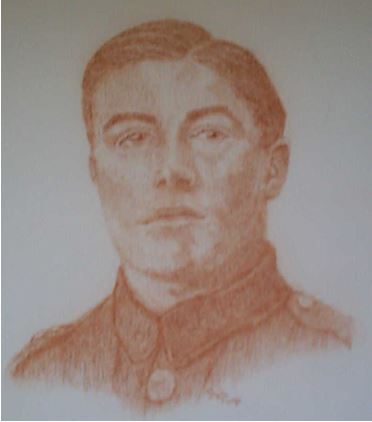All in all, seven of Myles McGrane’s grandchildren were named after him. Last week, I introduced you to the youngest, Myles Joseph McGrane (1904-1977). The eldest, my great-granduncle Myles Byrne (1873–1928), has also featured, as well as Myles Vickers (1900-1970). This week it is the turn of Myles McDonnell (1899-1918).
Myles McDonnell was born on 24 January 1899, the second son and fourth child of Catherine (Kate) McGrane and her husband Peter McDonnell. And, like so many of his extended McGrane-family, he was born in Lower Jane Place, off Oriel Street, in Dublin’s north inner city.
 |
Myles McDonnell (1899-1918),
sketched by his nephew, Thomas Turp
|
His parents married on the 18 May 1890, in the parish church of St Laurence O’Toole’s, and they had seven children; Michael in 1893, Annie in 1895, Margaret in 1897, Myles in 1899, Rosanna in 1901, Peter in 1903 and Anthony in 1905. They all survived childhood, bar Anthony, who died, aged only two weeks, on Christmas Day, 1905.
Myles lost his mother Kate when he was only thirteen years old. She caught influenza and died on 10 May 1912. She was probably buried in the cemetery at St Margaret’s, in Co. Dublin, in the same grave as her husband Peter, who lived until 1941. Available records for the cemetery do not commence until 1936.
Like his elder brother Michael, Myles joined the British Army and fought in the first World War. He enlisted with the Royal Dublin Fusiliers, serving in their 5th regiment and later joined the 7th Battalion of the Royal Irish Regiment (also known as the South Irish Horse). He died in action on 2 September 1918, just two months before the end of the war. Corporal Myles McDonnell was buried at Dranoutre Military Cemetery, in Belgium.
 |
William Orpen, 1917, South Irish Horse.
© IWM (Art.IWM ART 3027), A Dubliner resting on his way to Arras Front, Imperial War Museums |
It is a little surprising to find McGrane relatives among the ranks of the British army. In 1916, not long before Myles signed up, his first cousin Frank McGrane had been arrested and charged with absenting himself from British military service. He then vigorously resisted conscription, in the Irish courts. Around the same time, his other first cousin, Myles McGrane, served in the Old IRA, actively fighting the British forces in Ireland. Yet another first cousin, Frank Teeling, also fought in the War of Independence. He was sentenced to death by hanging for his part in the killing of Lieutenant Angliss, a British spy, on Bloody Sunday, in 1920 and would have died had he not escaped from prison. The McGrane family’s strong nationalist views are obvious - I wonder what they thought when the McDonnell boys enlisted.
One thing is sure, World War I was a double tragedy for the families of Irish soldiers who lost their lives. While they were away fighting to protect the small nations of Europe against 'German' invasion, the War of Independence was raging at home. It caused a deep-felt bitterness towards the British military in Ireland. So much so, families often mourned their loved-one’s passing in private - to do otherwise might invite open hostility. Irish society certainly did not recognise the war-dead as heroes and, although 200,000 Irishmen joined the army, and up to 50,000 lost their lives in the War, they were all but officially forgotten by the emerging Free State government.
But, Myles McDonnell remained a hero in his family. He was especially remembered by his sister Margaret (McDonnell) Turp, who emigrated to England in the 1920s. Perhaps living in England made it easier to keep his memory alive. Margaret’s son Thomas sketched the picture of Myles shown above, probably from an old photograph taken shortly before he went to war. In it, I can see the resemblance to his first cousin Thomas McGrane and even to his cousin, Benjamin Byrne.
Memorial Plaque
Myles McDonnell (1899-1918)
|
Thomas Turp later named his son 'Myles', after his uncle, and this son now proudly holds Myles McDonnell's Memorial Plaque. The Memorial Plaque, popularly known as the 'Dead Man's Penny', was issued to the next-of-kin of all British soldiers who died in the War.
Sources: Copy birth, marriage and death registers, General Register Office, accessed Civil Records on IrishGenealogy.ie; Burial register for St Margaret’s cemetery, Buried in Fingal; Myles McDonnell in Ireland's Memorial Records 1914-1918, p. 357, accessed 'Ireland, casualties of World War I, 1914-1922', Ancestry.com; Myles McDonnell in Soldier's Wills 1914-1918, National Archives; M McDonnell in the Commonwealth War Graves Commission.
And, a special thanks to Myles Turp for sharing his family pictures with us.
And, a special thanks to Myles Turp for sharing his family pictures with us.
………………
© Black Raven Genealogy

Hi Dara, This is a really interesting and thought provoking article - thanks for putting this together. It's also worth mentioning that Myles' eldest brother Michael McDonnell also took part in WW1. He survived the experience, despite being a dispatch rider (one of the most dangerous jobs!) so I suspect this is why Myles enlisted. It still begs the question about the family views on this subject, must have been very interesting times!
ReplyDeleteMyles Turp (Myles McDonnell's great-nephew)
Thanks again, Myles. I will see what I can find out about Michael's military service, if the records have survived. Interesting times indeed - I often wish I could sit down for a little chat with those long gone!
DeleteIreland has such a sad history! I'm glad Frank escaped his death sentence.
ReplyDeleteYes, it was often difficult, Ellie, but at least it was never boring! Ours might be the first generation to have it easy.
DeleteThat sketch of Myles is very nice. It is tragic that Myles & so many other young men had their lives cut short by war.
ReplyDelete